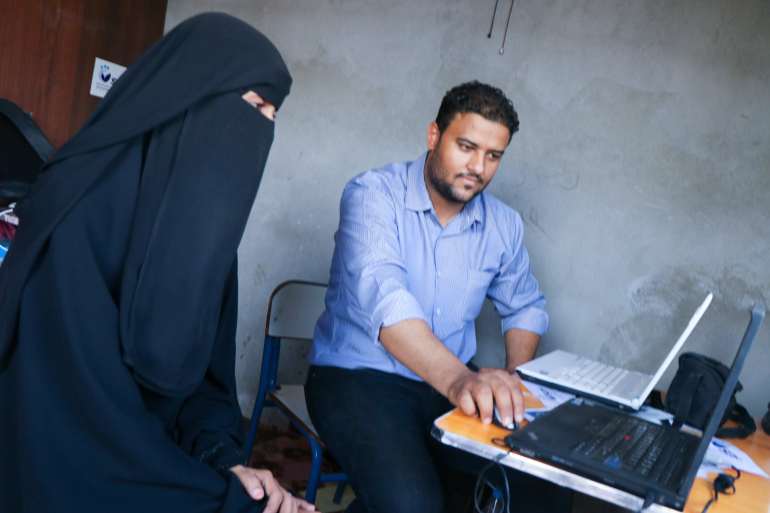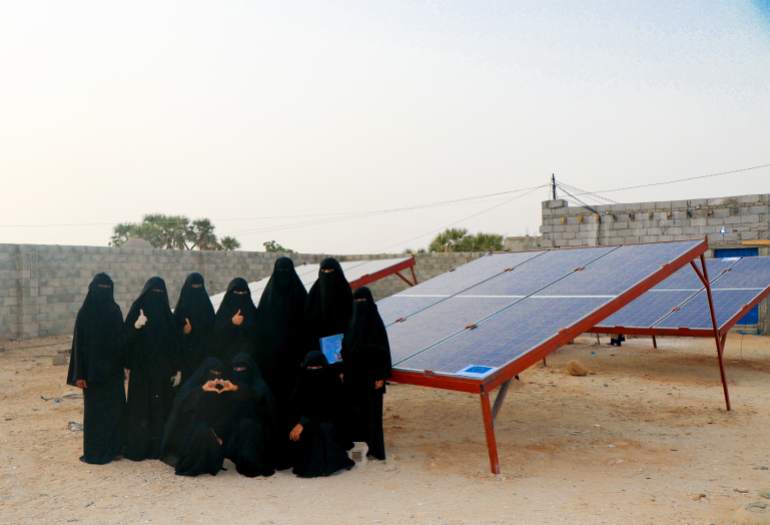Yemen’s ‘microgrid girls’ power community amid war and COVID-19
A women-run solar station near the front line in Abs is empowering its owners and improving life in their community.
![A woman checks batteries at the Abs solar microgrid station [Photo courtesy of SDF YEMEN]](https://www.aljazeera.com/wp-content/uploads/2020/10/yemen-3.jpg?resize=770%2C513)
“The role of women was housework only,” laments Huda Othman Hassan, a young woman from Abs, a rural district in the north of Yemen, near the border with Saudi Arabia.
“Although we are educated and university graduates, we had no decision-making power and couldn’t work in any field.”
The project is one of three the United Nations Development Programme helped put in place in front line off-grid communities in the country. The Abs station is the only one run entirely by women.
The other two – located in the Bani Qais district near Abs, and in the Lahij governorate in the southern part of the country – are managed by 10 young men each; 30 percent of them are people who are displaced.
Before the Abs station was built, Othman says, the high price of commercial electricity meant her community was unable to access it. “Most people used a flashlight or a five-watt bulb on a small battery,” she says.
Now, the solar microgrid provides the community with cheaper, clean, and renewable energy, while also tackling another major issue in this part of Yemen – helping women earn a stable income and gain new professional skills.
 Abs solar microgrid co-owners repair solar panels [Photo courtesy of SDF YEMEN]
Abs solar microgrid co-owners repair solar panels [Photo courtesy of SDF YEMEN]Yemen ranks at the bottom of the UN gender equality index and there are very limited work opportunities for women, especially in rural areas.
But for the group managing this project in Abs, the work has been transformative.
“At first, they made fun of us – that we want to do men’s work. But now, our community is respecting us, as we are business owners. They come to the station and ask us if there are opportunities. Now, they want their women to participate and succeed like the microgrid girls,” says Iman Ghaleb Al-Hamli, director of the station.
“The project has built our self-reliance, confidence in participating in society and broken the red line in dealing with men,” she adds. “And we are now contributing to the family monthly budget to cover food and other necessities.”
 The site of the solar microgrid project in Abs [Photo courtesy of SDF YEMEN]
The site of the solar microgrid project in Abs [Photo courtesy of SDF YEMEN]Producing and selling power
Before Yemen’s war started in 2015, finding food and fuel was already a struggle. Five years on, more than 80 percent of the population needs some sort of assistance and more than half of rural communities do not have access to energy as fossil fuel prices continue to surge and embargoes make fuel even more difficult to obtain.
In addition, COVID-19, which is now rampant in Yemen, is deepening the crisis.
This is the first time in Yemen that microgrids have been introduced to both produce and sell solar power – and they are believed to be the first privately run energy sources in the country.
Before the arrival of the grids, rural communities were reliant on diesel generators – polluting, expensive and susceptible to sudden shifts in the price of fuel.
Now, these three communities have access to sustainable energy and their electricity bills have been “cut by 65 percent”, according to Arvind Kumar, the UNDP’s Yemen project manager. While diesel costs $0.42 an hour, solar energy costs only $0.02, making it more affordable for Yemenis.
 A woman works at the Abs station [Photo courtesy of SDF YEMEN]
A woman works at the Abs station [Photo courtesy of SDF YEMEN]“Existing power plants are no longer functional in Yemen and the current energy-transportation infrastructure doesn’t extend to rural areas,” explained Kumar.
“These rural areas are the heart of Yemen’s economy where agriculture, water, public services and the local economy largely depends on fossil fuels. With no income, no jobs and oil price rising, the rural communities would always struggle to stand on their own feet. In this context, solar microgrids, which can be small or medium, are the way forward.”
In setting up its project, the UNDP provided seed grant money and trained the women in Abs and the young men in Bani Qais and Lahij to establish, manage and maintain solar microgrid businesses to bring electricity to their communities.
“I learned technical skills, such as charging batteries, connecting wires, measuring power using an Avometer, converting power from DC current to AC current and checking the capacity in KW,” says Amena Yahya Dawali, a technical officer at the Abs station.
The women’s 20-day training also covered business skills and finance, in addition to four days of orientation on a microgrid model. The project is also supported by the European Union and implemented by the Sustainable Development Foundation (SDF) and CARE International.
 A woman works at the Abs station [Photo courtesy of SDF YEMEN]
A woman works at the Abs station [Photo courtesy of SDF YEMEN]Community benefit
In Abs, the microgrid has improved life for the wider community.
“In my community, we used to go to sleep at seven o’clock in the evening. Now, we can accomplish many tasks at night,” Ghaleb says.
“There is a woman who sold one of her sheep and bought a sewing machine and now, she can do sewing in her home at night after her children sleep.”
Climate innovation charity Ashden awarded the project the 2020 Ashden Award for Humanitarian Energy. “Local NGOs thought the project would face huge challenges because it is highly technical and these women had never done anything remotely similar,” a spokesperson for the charity said.
“They said that if you are going to put this very expensive equipment in the hands of people who have never done that, it could be over within four months. But now more than a year on, the grid is still working, generating energy and incomes, and nothing has been stolen or vandalised. The community sees the benefits of it and protects it.”
The other two micro-grid stations are also functioning at full capacity, providing energy to commercial shops. Across all three solar microgrids, electricity sold by the project’s 30 owners has helped 70 times as many people. Some 2,100 people gained disposable income as they were able to start income-generating activities, such as sewing, welding, selling groceries and setting up commercial shops. Including those using the services and visiting the shops, approximately 10,000 people made indirect gains from sustainable energy in the three communities.
 A woman checks the metres at the Abs station [Photo courtesy of SDF YEMEN]
A woman checks the metres at the Abs station [Photo courtesy of SDF YEMEN]“The most revealing part of this initiative is to see beneficiaries no longer vulnerable and dependent on humanitarian aid as they now have a sustainable way to generate income, whereas, in other humanitarian interventions in Yemen, it is hard to find such evidence,” Kumar said.
These projects are even more important now that COVID-19 is spreading across the country.
“As we fight back against COVID-19, an already strained healthcare system, economy and society have been stretched to new limits,” said Auke Lootsma, UNDP’s Yemen resident representative. “If we want to meet the demand for power across these sectors, we need to continue building bold on-grid and off-grid decentralised energy solutions, and promote these solutions amongst development partners, private sector actors and international financial institutions.”
The next step for the programme is to secure funding from the private sector and microfinance institutions to build up to 100 additional microgrids in remote areas of the country, in order to keep schools and hospitals open during the conflict and the pandemic. The UNDP is also planning to pilot projects transforming waste into energy and desalination based on the same microgrid business model.
“The future is promising,” says Ghaleb. “Our dream has been fulfilled with this first station, and now we aspire to cover the entire region.”
 The ‘microgrid girls’ alongside solar panels at the project in Abs [Photo courtesy of SDF YEMEN]
The ‘microgrid girls’ alongside solar panels at the project in Abs [Photo courtesy of SDF YEMEN]